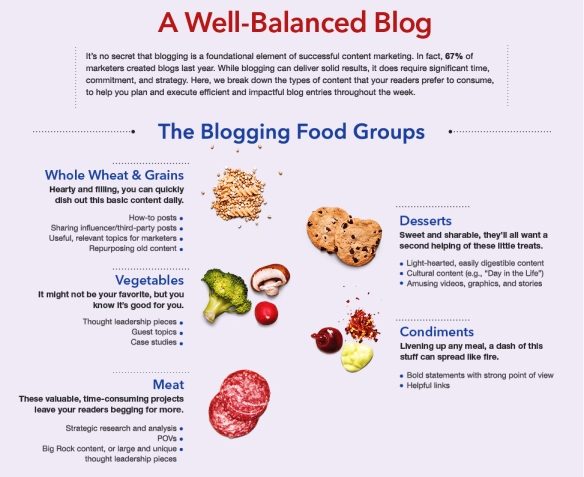Happy Friday! I hope everyone has enjoyed the week and has great plans for the weekend! Once again I am coming to the end of a week having run in sub-zero temperature … But since I PROMISED no more ‘sub-zero selfies, I didn’t take one.
I have often talked about how much I really enjoy the blogging community both in terms of people who stop by here and reading everyone else’s amazing content. But I have also noticed that as I find more great blogs, my ability to keep up with them all diminishes … and I feel that putting out more than one post per day is just too much.
That is why I held off on my ‘What I’m Listening to Wednesday’ and ‘Thought for Thursday’ – I am not abandoning music posts, but will include them as part of daily posts. And I think I am already doing enough ‘thought’-oriented posts!
1. Blogging ‘food groups’
This is a bit meta, but since many of the people who will read this have their own blogs, it seems to be appropriate. LinkedIn Marketing put together some thoughts and an infographic about how to maximize the value of your blog for your readers.
Audience engagement is the definitive measure of a blog’s success, whether you’re blogging for a marketing firm or simply to indulge your own interests. You’ve probably watched as some posts go viral while others sit quietly in the corner.
This goes along with a similar theme from Net Translators, again taking a food theme and comparing bloggers and dieters. The info graphic at the top is just a snip of the full one available at Mashable.
Since my basic approach is writing about what I like and what interests me, I am not as interested in ‘marketing’ … but the audience engagement is wonderfully addictive, so I read through these articles. Not sure if I will do anything with it all .. how about you?
2. ObamaCare and ‘Woman’ as a Pre-Existing Condition
I liked this set of infographics from UpWorthy about the impact of ObamaCare for women, but what really caught my eye was the statement that one benefit of the ACA is that ‘being female can no longer be used as a pre-existing condition’. So I did a quick search and found this blog at the NYT from 2010. What it noted was:
some companies charged women who did not smoke more than men who did, even though smokers have more risks.
Personally, this is the type of thing that reminds me WHY despite certain political groups constantly crowing how we in the US have hte ‘#1 healthcare system in the world’ … there are NO surveys done that take the patient cost and coverage and experience into account that even rank us in the top 10. I think at best the ACA is ‘flawed’, but anything that removes some of the most brain-dead restrictions is better than where we are.
3. ‘Bossy’ as a Female Trait?
I had seen this Sheryl Sandberg article from the WSJ elsewhere, but it really hit home when I saw it again at Broadsideblog the other day.
Basically, it notes that the term ‘bossy’ is always negative, and almost always used to describe women. This has been true historically, dating back to the first dictionary appearance in the 1880s:
Ngram analysis of digitized books over the past 100 years found that the use of “bossy” to describe women first peaked in the Depression-era 1930s, when popular sentiment held that a woman should not “steal” a job from a man, and reached its highest point in the mid-1970s as the women’s movement ramped up and more women entered the workforce.
The article also notes that in dictionaries where a sentence is used for content, a female description is almost universally used, and even in current books the term is ascribed to women at a rate of four times more often than men, and again – always as a negative.
So what Sandberg recommend? Follow CBS anchor Norah O’Donnell and the next time you hear a girl (or woman) called bossy, say “That girl’s not bossy. She has executive leadership skills.”
4. 15 Must Share Science Gifs
OK, so I am a science nerd, this we all know … so I have been mesmerized by this set of 15 science gifs all week. I could have chosen from several … but I really love this candle relighting gif:
As an aside – how do YOU pronounce ‘gif’? Like ‘jif’ (as in the peanut butter)? Or like it is pronounced in ‘gift’?
5. Some Amazing Peanut Butter Recipes
OK, so last week I already noted peanut butter as one of my absolute faves … so this article at Greatist with a ton of healthy peanut butter recipes? I was all over it!
The one I really plan to try soon? A healthy peanut butter centric breakfast! OK … so I actually made it last night and had it this morning. Behold my food photography master skills! (haha)
Bonus. Best Books of the 21st Century
[UPDATE: The creator of this info graphic contacted me, so I wanted to be sure it was properly attributed!]
You know, the 21st century has actually seen some really good books published! How many of the ‘best books’ have YOU read? Check out this great infographic from MAT Online at USC Rossier:
What have you been reading or thinking about this week?







